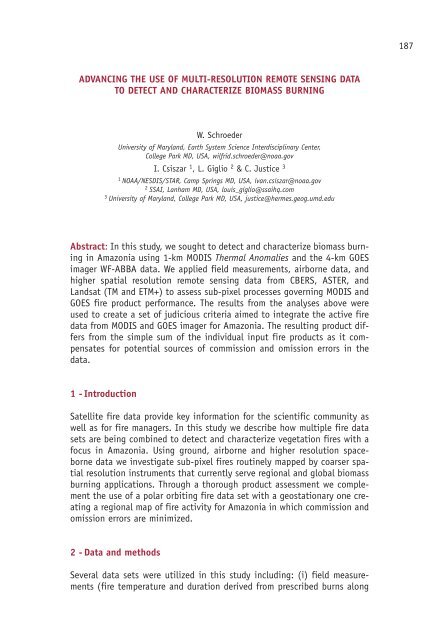7th Workshop on Forest Fire Management - EARSeL, European ...
7th Workshop on Forest Fire Management - EARSeL, European ...
7th Workshop on Forest Fire Management - EARSeL, European ...
You also want an ePaper? Increase the reach of your titles
YUMPU automatically turns print PDFs into web optimized ePapers that Google loves.
ADVANCING THE USE OF MULTI-RESOLUTION REMOTE SENSING DATA<br />
TO DETECT AND CHARACTERIZE BIOMASS BURNING<br />
W. Schroeder<br />
University of Maryland, Earth System Science Interdisciplinary Center,<br />
College Park MD, USA, wilfrid.schroeder@noaa.gov<br />
I. Csiszar 1 , L. Giglio 2 & C. Justice 3<br />
1 NOAA/NESDIS/STAR, Camp Springs MD, USA, ivan.csiszar@noaa.gov<br />
2 SSAI, Lanham MD, USA, louis_giglio@ssaihq.com<br />
3 University of Maryland, College Park MD, USA, justice@hermes.geog.umd.edu<br />
Abstract: In this study, we sought to detect and characterize biomass burning<br />
in Amaz<strong>on</strong>ia using 1-km MODIS Thermal Anomalies and the 4-km GOES<br />
imager WF-ABBA data. We applied field measurements, airborne data, and<br />
higher spatial resoluti<strong>on</strong> remote sensing data from CBERS, ASTER, and<br />
Landsat (TM and ETM+) to assess sub-pixel processes governing MODIS and<br />
GOES fire product performance. The results from the analyses above were<br />
used to create a set of judicious criteria aimed to integrate the active fire<br />
data from MODIS and GOES imager for Amaz<strong>on</strong>ia. The resulting product differs<br />
from the simple sum of the individual input fire products as it compensates<br />
for potential sources of commissi<strong>on</strong> and omissi<strong>on</strong> errors in the<br />
data.<br />
1 - Introducti<strong>on</strong><br />
Satellite fire data provide key informati<strong>on</strong> for the scientific community as<br />
well as for fire managers. In this study we describe how multiple fire data<br />
sets are being combined to detect and characterize vegetati<strong>on</strong> fires with a<br />
focus in Amaz<strong>on</strong>ia. Using ground, airborne and higher resoluti<strong>on</strong> spaceborne<br />
data we investigate sub-pixel fires routinely mapped by coarser spatial<br />
resoluti<strong>on</strong> instruments that currently serve regi<strong>on</strong>al and global biomass<br />
burning applicati<strong>on</strong>s. Through a thorough product assessment we complement<br />
the use of a polar orbiting fire data set with a geostati<strong>on</strong>ary <strong>on</strong>e creating<br />
a regi<strong>on</strong>al map of fire activity for Amaz<strong>on</strong>ia in which commissi<strong>on</strong> and<br />
omissi<strong>on</strong> errors are minimized.<br />
2 - Data and methods<br />
Several data sets were utilized in this study including: (i) field measurements<br />
(fire temperature and durati<strong>on</strong> derived from prescribed burns al<strong>on</strong>g<br />
187
















